
Name : pronunciation
Western Dragon : whes-turn drag-en
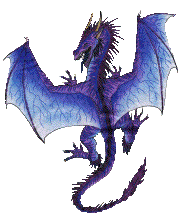
PHYSIOLOGY: Thick, long bodied, scaly skin, four strong legs, two bat-like wings, wedge-shaped heads, and long necks. They usually are portrayed as breathing fire. Some breeds of these dragons have been known to be shape changers, and others have the chameleon power to change color of their background. They are sometimes displayed as having a spade or spiked tail. They eat but once a month on a sheep or ox, or even a human (myth says they prefer virgin maidens). They can be any color, or many colors, depending on the breed of the dragon. See the dragon Physiology page for more info.
HISTORY: When most people think "dragon" they most likely think of the Western dragon. Western dragons are usually portrayed as evil, mean, and bloodthirsty. They were also known to have huge hoards of gold and jewels hidden in their lairs. The most famous dragons are portrayed as Western-type dragons: St. George and the Dragon
, Beowulf and the Dragon, and Draco in the movie DragonHeart. Some stories have the western dragon as the Devil in Christianity. Other stories in legend say that eating a dragons' heart will give the consumer the power of understanding birds, eating the dragons' tongue enables the person to win any argument, and rubbing the dragons' blood on skin will protect against stab wounds. Another myth references Vlad Drakul to mean Son of the Dragon, or Devil. The end of the dragon came with Christianity, and knights that were eager to prove their faith. The knights quickly discovered that dragon-hunting was very profitable, and soon most the dragons in the world were destroyed in a very short time. Vikings had dragon figureheads on the prow of their ships. The dragons on the ships were believed to endow keen site and cunning to the Viking warriors. Today the Welsh flag still has a red dragon on a green/white background, and the red dragon is their national symbol.
Eastern Dragon : ees-turn drag-en
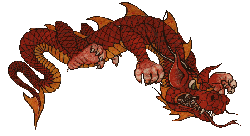
PHYSIOLOGY: These three species of dragons look very similar, but come from different parts of the world. They all have sinuous serpentine bodies, have four legs, they do not usually breath fire, usually shown not to have wings, but are illustrated to have them which is the Adult Imperial Dragon. The dragons are said to be made up of many different types of animals of the Earth: the body of a snake, scales of a carp (fish), head of a camel, horns of a giant stag (deer), the eyes of a hare (rabbit), ears like a bull, a neck like an snake, belly of a clam, paws like a tigers, and claws like an eagle. Most of the time they are shown to have a lion-type mane around its neck, on its chin, and on each elbow. They have two antler-type horns decorating their wide-mouthed head, and two long "feeler" whiskers spreading out from their snout. Eastern dragons have 117 scales, 81 infused with yang, the good, and 36 infused with yin, the bad. This evens out the dragons temper and personality.
There are three families of Eastern dragons: 3 toed, 4 toed, and 5 toed. Three toed dragons are Japanese. Four toed dragons are Indonesian or Korean. Five toed dragons are Chinese. They are shown in the colors blue, black, white, red, or yellow. Oriental dragons are usually shown with a pearl in their mouth, under their chin, or in their claws. This is apparently where the dragon gets its power, and how it ascends to heaven. Roasted swallows are the Chinese dragon's favorite food.
HISTORY: In China dragons are known as Lung. There are four main kinds of Lung: Tien-lung , The Celestial Dragon: who protect the places of the Gods, Shen-Lung, The Spiritual Dragon: who control the wind and the rain, Ti-Lung , The Earth Dragon which control rivers, and water on the Earth, and Fut's-Lung , The Underworld Dragon which guards precious metals and gems. Separate dragons control the rivers of the North, South, East and West. The commander of all the River Dragons is Great Chien-Tang who is blood red, has a firey mane, and is 900 feet long.
Eastern dragons are portrayed as good, kind, and intelligent. Oriental Dragons have the most recorded history in the world, especially in China going back thousands of years. In history they have a very close link to the weather. It is said that some of the worst flooding in Asia's History were caused when a mortal has upset a dragon. In Chinese history, the 5 toed dragon is the symbol of power, and are considered "Imperial Dragons". Long ago, it became law in China that only the Emperor could have a five-clawed dragon displayed on his robes or illustrated on anything the Emperor owned. It was usually a Yellow dragon, thought to be the most superior of all the colored dragons. If someone other than the Emperor was caught wearing the symbol of the 5-toed dragon, he was put to death. More about the Chinese Dragon.
Eastern dragons are still shown in parades around the world celebrating the Chinese New Year with the Dragon Dance.
Learn more about Eastern Dragons, follow these links!
Dragons in Ancient China
Chinese Dragons
Faerie Dragon : fair-ee drag-en
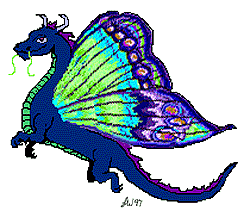
PHYSIOLOGY: Very small dragons, being only 1'-5' long, any color, with large eyes, and large butterfly-type wings. These dragons are vegetarian as they only eat fruit, vegetables, nuts, and so on.
HISTORY: These are the rarest of all the dragon, as only a few have ever been reported. Some myths might come from some large butterflies that are around the world. It is said in legend that these dragons sometimes carry faeries from city to city. Since only a few have ever been seen, the history of these types of dragons are next to none.
Wyvern : wi-vurn
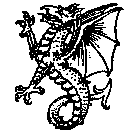
PHYSIOLOGY: These are dragons which have two wings, but only two legs. Sometimes shown as having claws on the wings, acting like another pair of "hands". The Wyvern is sometimes depicted as having a razor sharp stinger filled with poison on the end of its tail.
HISTORY: The history of the wyvern seems to come from Europe. The history of this dragon is not so clear, it seems to be mixed in with the history of the 4-legged dragon. Wyvern's have been depicted in heraldry on shields and banners for hundreds of years, and is considered a sign of strength to those who bear the symbol. One of the more famous wyverns is Vermithrax in the movie DragonSlayer.
Hydra : hi-drah
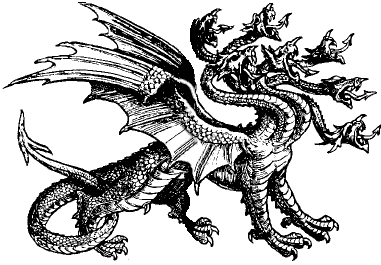
PHYSIOLOGY: These are dragons which have multiple necks and heads. They may or may not have wings or legs.
HISTORY: In Greek mythology Hercules fought a grand hydra with 8 heads (history tells us 6 to 9 heads for this particular hydra). Every time he managed to slash one off with sword, two would come in its place. He finally figured out by burning the stump with a torch, it could not grow another head. That is how Hercules rid the world of the mighty hydra. Also in Greek mythology, Jason killed a hydra to get the Golden Fleece.
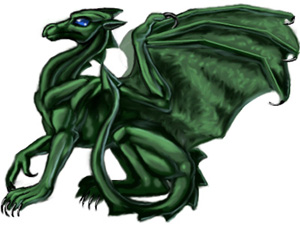
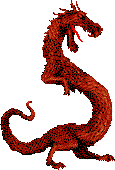
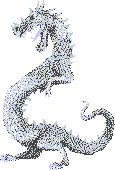
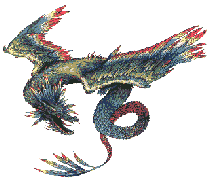
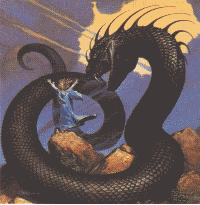
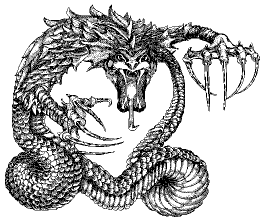
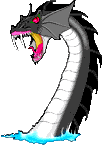
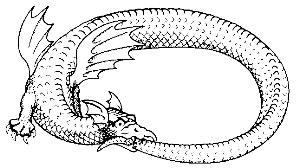
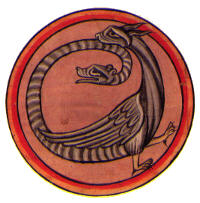
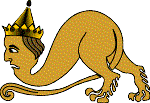
Dragons have been in mythology and legend for thousands of years. Almost every country in the world as some sort of dragon story. Where did they originate from? Did people actually SEE dragons? By some strange chance, were their dinosaurs still roaming the earth only a few thousand years ago? Were some of the dragons people saw actually lizards that have extra skin, and can glide such as the Kuehneosaurus,or the flying dinosaurs the Archaeopteryx or Pterosaurs?
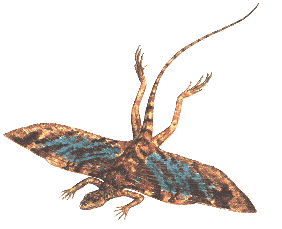
Maybe, but these are questions no one can answer. Dragons will always live on the Earth, we do have real dragons here! There is even a genus of lizard called draco. Two "dragon" lizards are water dragons, and http://www.bagheera.com/Komodo dragons. The water dragon is a popular small lizard to keep as pets. The Komodo dragon (not discovered until 1912!) is the largest known lizard today, reaching lengths of 10 feet, and 150 pounds. The bright yellow tongue could be mistaken for a flame, and its vicious nature would scare anyone away.
Some other "dragons" are the Dragonfly, and the Snapdragon flower. The Dragonfly could have been mistaken for a small flying dragon in the past, although, in Jurassic times, Dragonflies were as big as a seagull. The Snapdragon flower looks like a red mouth with a gaping yellow throat, which could be where it's name came from. Humans have even named one of the Constellations in the sky Draco for the shape of the constellation is that of a dragon.